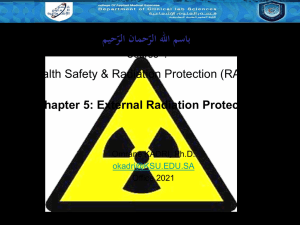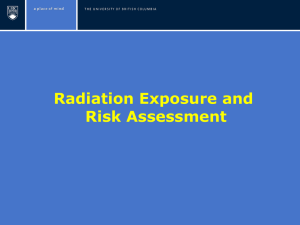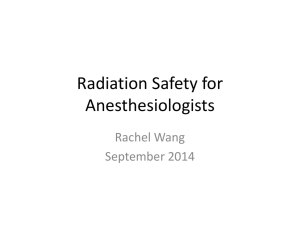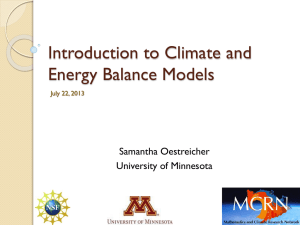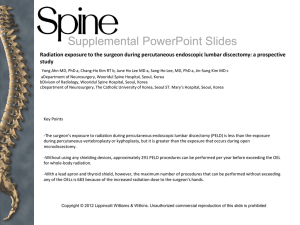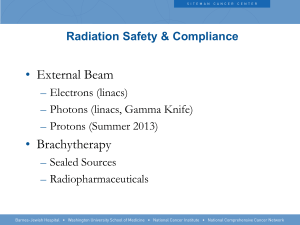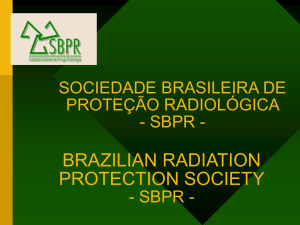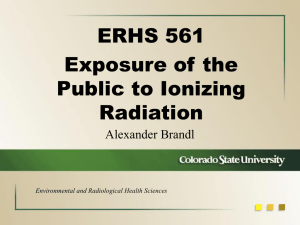Mertens_NAIRAS_Aircraft_LWS_ESWE_2012
advertisement
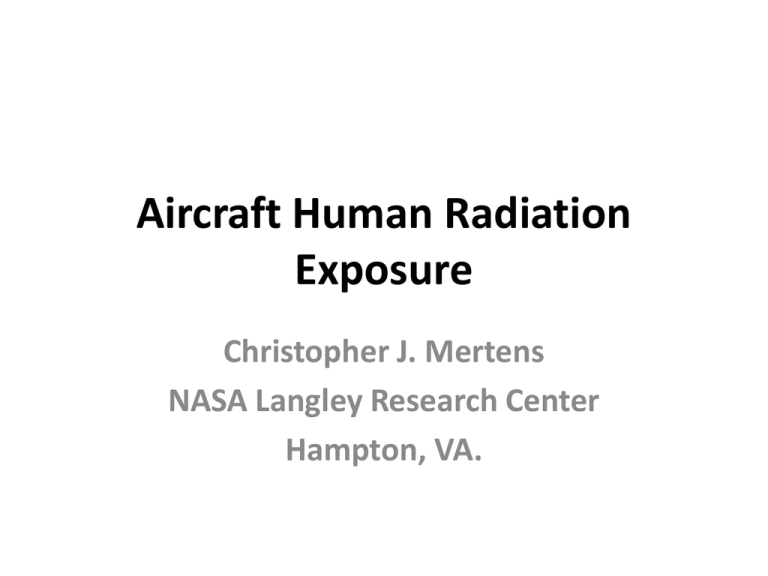
Aircraft Human Radiation Exposure Christopher J. Mertens NASA Langley Research Center Hampton, VA. Radiation Storms: Impact on Air Travel • Radiation Exposure to Commercial Aircrew and Passengers – The ICRP classify commercial aircrew as occupational radiation workers – The NCRP reported that flight crews receive the largest annual effective dose among occupational radiation workers – Current guidelines for maximum public and prenatal exposure can be exceeded (1 mSv) on high-latitude commercial routes during a single solar radiation storm event or for frequent flyer exposure to high-latitude background levels (~ 10 flights/yr during solar minimum) • Increased Number of Commercial Polar Routes – United Airlines flew 12 demo polar flights in 1999 – United Airlines flew 1832 polar flights in 2007 Radiation Storms: Impact on Air Travel • Summary of DOC (NOAA/SWPC) Report [2004] – Typical cost savings from US-China cross-polar route ~ $35k-$45k per flight compared to previous non-polar route – However, rerouting polar flight can cost up to $100k per flight is fuel stops and layovers are necessary – FAA issued radiation advisory during Halloween 2003 storm and one major airline rerouted six polar flights, which included fuel stops. This cost the airline as much as $600k • Other Reroutes – United rerouted 26 polar flights during January 2005 storm period and 5+ polar flights during the December 2006 storm period – Delta Airlines rerouted 8 polar flights during January 2012 storm period and 8+ polar flights during March 2012 storm period. • The Emerging Commercial Space Transportation Industry and Space Tourism Nowcast of Atmospheric Ionizing Radiation (NAIRAS) Model • What Does NAIRAS Provide? – Real-time effective dose rates from physics-based models – GCR and SEP sources – 1x1 lat/lon geographic grid, 0-100 km with 1 km vertical resolution, 1-hr time cadence – Geomagnetic influences from solar-wind / magnetosphere coupling – Various graphical displays of effective dose rates and representative high-latitude flight-accumulated effective dose. NASA’s NAIRAS Model Predictions During March 2012 Solar Storm Events Public Web site: http://sol.spacenvironment.net/~nairas/ (or google NAIRAS) ESWE Workshop: An Aviation Radiation Perspective • What constitutes an extreme space weather event (Tuesday morning session)? – Any event that would require airlines to reroute flights in order to avoid ICRP public/prenatal exposure limits from being reached/exceeded – What are the radiation effects on microelectronic systems for commercial air/spaceflight? • What recent space weather event(s) to include in “campaign” analysis (Tuesday afternoon session)? – January 20, 2005 SEP event: (1) “challenging” ion spectra, (2) high anisotropy – Neutron monitor site at Tibet (~ 14 GV) measured GLE of 2.4%, indicating sufficiently large number of ~ 14 GeV protons! – Peak incident SEP ion flux and subsequent atmospheric radiation dose occurred in southern hemisphere in first few hours of the event Backup Slides Nowcast of Atmospheric Ionizing Radiation for Aviation Safety (NAIRAS) Model NOAA/GOES +NASA/ACE Data Cutoff Rigidity (IGRF) Real-time Neutron Monitor Data (e.g., IZMIRAN and LOMNICKY) Fit to Climax HP Spectral Fitting Magnetospheric Magnetic Field (e.g., T05) Effects on Cutoff Rigidity NASA/ACE Solar Wind and IMF Data Badhwar+O’Neill GCR Model HZETRN + Dosimetry Atmospheric Density NCEP/GFS Atmospheric Dose and Dose Equivalent Carrington Event • SEP Spectral Fluence [Smart et al., 2006; Townsend et al., 2006] – Five measured spectral shapes considered o August 1972 (soft) o September 1989 (hard) – Spectral shapes normalized to >30 MeV proton fluence determined by impulsive NOy deposition in polar ice cores [McCracken et al. 2001] – Lack of detectable increase in annual 10Be deposition in polar ice favors a soft spectrum Carrington Event • Geomagnetic Storm [Li et al., 2006] – H-component depression measured in India and taken as Dst – Solar wind shock velocity: determined from time between flare and magnetic disturbance – Temerin and Li [2002] Dst model fits measured Hcomponent depression o Interplanetary Ey = VxBz determine maximum Dst depression o Large solar wind density (to calculate dynamic pressure) needed to reproduce rapid recovery Carrington 1859 Carrington 1859 Carrington 1859 Carrington 1859 Carrington 1859 Aircraft Radiation Exposure Medical Research • Cosmic rays can directly break DNA strands in biological tissue, or produce chemically active radicals in tissue that alter the cell function [Wilson et al., 2005, 2003] – Both can lead to cancer • Other adverse health effects include, but are not limited to, reproductive disorder and prenatal injury [Lauria et al., 2006; Waters et al., 2000; Aspholm et al., 1999] • Because aircrew total career dose is received is low doses per flight, and accumulated slowly over the length of a flying career, the direct evidence that a person can develop cancer as a result of cosmic radiation is inconclusive – Other lifestyle risk factors exist over a flying career • However, radiation protection community accepts the Linear No Threshold (LNT) theory – Every radiation exposure will have an effect on human health NIOSH Exposure Assessment of US Commercial Pilots Poster 6/10 Soc Epi Res; manuscript in review FIRST STUDY OF • US commercial pilot career exposure profile from individual flight segments: • Cosmic radiation • Solar energetic particle events • Chronic circadian disruption FINDINGS • A median pilot incurred • 34.4 mSv GCR and flew through 6 SEPs in 28 y flying • 1.92 mSv in the last study year • Exposure metrics increased markedly 1990+ IMPLICATIONS • No dose limits for US crew • Median pilot would trigger EU radiation monitoring (>1mSv/y) • A pregnant female pilot could exceed ICRP guidelines for pregnant radiation workers • High-exposed pilots at increased risk Image courtesy of Kanzelhöhe Observatory Aircraft Radiation Exposure Recommendations and Actions • Europe – EU Directive 96/29/EURATOM (1996) – Legal regulations on radiation protection of aircrew implemented into national law with EU member states by 2000 – Exposures must be assessed if 1 mSv/yr is likely to be exceeded – 6 mSv/yr “action level” (ALARA principle) o Individual record keeping and medical surveillance required – Monitoring recommended under 6 mSv/yr – German implementation o Operational GCR radiation exposure assessment using approved code o No approved operational SEP radiation exposure assessment o Some airlines interested in concomitant radiation measurements • Japan – State regulations recommend airlines try to keep aircrew exposure below 5 mSv/yr, which is the exposure dose limit for other occupationally exposed workers in Japan Aircraft Radiation Exposure Recommendations and Actions • USA – ICRP recommendations (< 20 mSv/yr, < 1 mSv during pregnancy) – Pregnant crewmember no more than 0.5 mSv in any month (FAA recommendation) • Current development of SpWx/aircraft radiation requirements Radiation measurements/predictions CPWG SpWx User Needs ICAO SpWx User Requirements WMO Radiation assessment FAA SpWx AWG User Needs FAA ICAO: International Civil Aviation Organization NOAA/ SWPC SEP Aircraft Radiation Exposure High-Latitude Flights • Roughly three SEP events per solar cycle with sufficient flux and energy to significantly increase atmospheric radiation above GCR • February 1956 Event (Wilson et al., 1995) – Commercial: ~ 5 mSv • October 1989 Event (AMS & SolarMetrics, 2007) – Commercial: ~ 2 mSv • Halloween 2003 Event (Mertens et al., 2010) – Commercial (11 km, 10-hr): ~ 0.2 mSv – Executive (15 km, 10-hr): ~ 0.4 mSv • January 2005 Event (NAIRAS; Copeland et al., 2008) – Commercial (11 km, 10-hr): ~ 1 mSv – Executive (15 km, 10-hr): ~ 4 mSv

